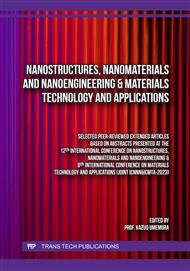[1]
Klevens RM et al., "Estimating Health Care-Associated Infections and Deaths in U.S. Hospitals, 2002," Public Health Rep., vol. 122, no. 2, 2007.
Google Scholar
[2]
A. Cassini et al., "Burden of Six Healthcare-Associated Infections on European Population Health: Estimating Incidence-Based Disability-Adjusted Life Years through a Population Prevalence-Based Modelling Study," PLoS Med., vol. 13, no. 10, 2016.
DOI: 10.1371/journal.pmed.1002150
Google Scholar
[3]
T.F. Mah, "Biofilm-specific antibiotic resistance," Future Microbiology. 2012.
DOI: 10.2217/fmb.12.76
Google Scholar
[4]
E.P. Ivanova et al., "Natural bactericidal surfaces: Mechanical rupture of pseudomonas aeruginosa cells by cicada wings," Small, vol. 8, no. 16, 2012.
DOI: 10.1002/smll.201200528
Google Scholar
[5]
S. Dai, D. Zhang, Q. Shi, X. Han, S. Wang, and Z. Du, "Biomimetic fabrication and tunable wetting properties of three-dimensional hierarchical ZnO structures by combining soft lithography templated with lotus leaf and hydrothermal treatments," CrystEngComm, vol. 15, no. 27, 2013.
DOI: 10.1039/c3ce40238j
Google Scholar
[6]
K. Mediaswanti, "Influence of Physicochemical Aspects of Substratum Nanosurface on Bacterial Attachment for Bone Implant Applications," Journal of Nanotechnology, vol. 2016. 2016.
DOI: 10.1155/2016/5026184
Google Scholar
[7]
F. Jipa, M. Zamfirescu, A. Velea, M. Popescu, and R. Dabu, "Femtosecond Laser Lithography in Organic and Non-Organic Materials," in Updates in Advanced Lithography, 2013.
DOI: 10.5772/56579
Google Scholar
[8]
L.J. Jiang, J.H. Campbell, Y.F. Lu, T. Bernat, and N. Petta, "Direct writing target structures by two-photon polymerization," in Fusion Science and Technology, 2016, vol. 70, no. 2.
DOI: 10.13182/FST15-222
Google Scholar
[9]
X.Zhou, Y.Hou, and J.Lin, "A review on the processing accuracy of two-photon polymerization," AIP Adv., 2015.
DOI: 10.1063/1.4916886
Google Scholar
[10]
M. Emons, K. Obata, T. Binhammer, A. Ovsianikov, B. N. Chichkov, and U. Morgner, "Two-photon polymerization technique with sub-50 nm resolution by sub-10 fs laser pulses," Opt. Mater. Express, 2012.
DOI: 10.1364/ome.2.000942
Google Scholar
[11]
S.M. Kelleher et al., "Cicada Wing Surface Topography: An Investigation into the Bactericidal Properties of Nanostructural Features," ACS Appl. Mater. Interfaces, vol. 8, no. 24, 2016.
DOI: 10.1021/acsami.5b08309
Google Scholar
[12]
M.T.T. Thi, D. Wibowo, and B.H.A. Rehm, "Pseudomonas aeruginosa biofilms," International Journal of Molecular Sciences, vol. 21, no. 22. 2020.
DOI: 10.3390/ijms21228671
Google Scholar
[13]
S. Pogodin et al., "Biophysical model of bacterial cell interactions with nanopatterned cicada wing surfaces," Biophys. J., vol. 104, no. 4, 2013.
DOI: 10.1016/j.bpj.2012.12.046
Google Scholar
[14]
D.P. Linklater, V.A. Baulin, S. Juodkazis, R.J. Crawford, P. Stoodley, and E.P. Ivanova, "Mechano-bactericidal actions of nanostructured surfaces," Nature Reviews Microbiology. 2021.
DOI: 10.1038/s41579-020-0414-z
Google Scholar
[15]
S. O'Halloran, A. Pandit, A. Heise, and A. Kellett, "Two-Photon Polymerization: Fundamentals, Materials, and Chemical Modification Strategies," Advanced Science, vol. 10, no. 7. 2023.
DOI: 10.1002/advs.202204072
Google Scholar
[16]
M. N. Dickson, E. I. Liang, L. A. Rodriguez, N. Vollereaux, and A. F. Yee, "Nanopatterned polymer surfaces with bactericidal properties," Biointerphases, 2015.
DOI: 10.1116/1.4922157
Google Scholar
[17]
S. Baron, Medical Microbiology. 4th edition. 1996.
Google Scholar
[18]
S. Wu, F. Zuber, K. Maniura-Weber, J. Brugger, and Q. Ren, "Nanostructured surface topographies have an effect on bactericidal activity," J. Nanobiotechnology, 2018.
DOI: 10.1186/s12951-018-0347-0
Google Scholar
[19]
C. D. Bandara et al., "Bactericidal Effects of Natural Nanotopography of Dragonfly Wing on Escherichia coli," ACS Appl. Mater. Interfaces, vol. 9, no. 8, 2017.
DOI: 10.1021/acsami.6b13666
Google Scholar
[20]
J. Hasan, S. Jain, R. Padmarajan, S. Purighalla, V. K. Sambandamurthy, and K. Chatterjee, "Multi-scale surface topography to minimize adherence and viability of nosocomial drug-resistant bacteria," Mater. Des., 2018.
DOI: 10.1016/j.matdes.2017.11.074
Google Scholar
[21]
Z. Yang, X. Bai, X. He, and C. Yuan, "Study on biomimetic antifouling surface preparation based on surface microstructure of crabs," 2019.
DOI: 10.1109/ICTIS.2019.8883729
Google Scholar
[22]
J. Hasan, S. Raj, L. Yadav, and K. Chatterjee, "Engineering a nanostructured 'super surface' with superhydrophobic and superkilling properties," RSC Adv., 2015.
DOI: 10.1039/c5ra05206h
Google Scholar
[23]
X. Jing, H. Fu, B. Yu, M. Sun, and L. Wang, "Two-photon polymerization for 3D biomedical scaffolds: Overview and updates," Frontiers in Bioengineering and Biotechnology, vol. 10. 2022.
DOI: 10.3389/fbioe.2022.994355
Google Scholar



